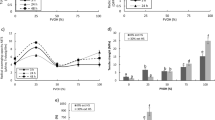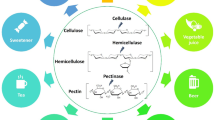Abstract
The effect of a-acetolactate decarboxylase (ALDC) on the diacetyl content of beer was studied. Diacetyl is known as an off-flavor compound in beer due to its buttery flavor. ALDC is known to reduce diacetyl by bypassing the diacetyl formation pathway. Herein, beer was brewed with two-row barley (Jinyang) and six-row barley (Dahyang) cultured in Korea with the addition of ALDC. The formation of diacetyl is reversely affected by free amino nitrogen, such as valine. ALDC (0.02, 0.04, and 0.06 unit/mL) was added to the samples, and the physicochemical properties of the resulting beer were analyzed to determine the quality. Diacetyl content was decreased in proportion to the enzyme concentration. The diacetyl content in samples made from Jinyang and Dahyang decreased by 25 and 15%, respectively. The diacetyl content in both was acceptable for microbrewery.
Similar content being viewed by others
References
García AI, García LA, Diaz M. Modelling of diacetyl production during beer fermentation. J. I. Brewing. 100: 179–183 (1994)
West DB, Lautenbach AL, Becker K. Studies on diacetyl in beer. pp. 81–88. In: American Society of Brewing Chemists Annual Meeting. May 8, King Edward Hotel, Toronto, Canada. American Society of Brewing Chemists, Madison, WI, USA (1952)
Etievant PX. Wine. pp. 483–546. In: Volatile Compounds in Food and Beverages. Maarse H (ed). CRC Press, Inc., Boca Raton, FL, USA (1991)
García-Villanova RJ, García-Estepa RM. Vicinal diketones in foods: Significance, origin and analysis. An. Bromatol. 39: 297–394 (1987)
Peynaud E, Bolunin J. The Taste of Wine: The Art and Science of Wine Appreciation. John Wiley and Sons, Hoboken, NJ, USA. p. 347 (1987)
Owades JL, Maresca L, Rubin GT. Nitrogen metabolism during fermentation in the brewing process. II. Mechanism of diacetyl formation. pp. 22–26. In: American Society of Brewing Chemists Annual Meeting. May 14, Montreal, Quebec, Canada. American Society of Brewing Chemists, New York, NY, USA (1959)
Bayne PD, Kozulis JA. Fermenting and aging malt beverage. U.S. Patent 3,484,244 (1969)
Masschelein CA. The biochemistry of maturation. J. I. Brewing 92: 213–219 (1986)
Baker DA, Kirsop BH. Rapid beer production and conditioning using a plug fermentor. J. I. Brewing 79: 487–494 (1973)
Inoue T, Yamamoto Y. Diacetyl and beer fermentation. pp. 158–165. In: American Society of Brewing Chemists Annual Meeting. May 14, Detroit, MI, USA. American Society of Brewing Chemists, New York, NY, USA (1970)
Engan S. Beer composition: Volatile Substances. Vol. 1, pp. 93–165. In: Brewing Science. Pollock JRA (ed). Academic Press, Waltham, MA, USA (1981)
Linko M, Haikara A, Ritala A, Pentilä A. Recent advances in the malting and brewing industry. J. Biotechnol. 65: 85–98 (1998)
George C. The Analysis and Control of Less Desirable Flavors in Foods and Beverages. Academic Press, Waltham, MA, USA. p. 368 (2012)
Sinha NK. Handbook of Food Products Manufacturing. John Wiley and Sons, Hoboken, NJ, USA. p. 850 (2007)
Yamaguchi Y, Okamoto T, Murayama H, Kajino K, Amikura T, Hiratsu H, Nagara A, Noguchi K. Rapid maturation of beer using an immobilized yeast bioreactor. 2. Balance of total diacetyl reduction and regeneration. J. Biotechnol. 38: 109–116 (1995)
Godtfredsen SE, Ottesen M, Bent A. Larsen. A process for producing of fermented alcoholic products. European Patent 19,810,303,606 (1981)
Godtfredsen SE, Ottesen M. Maturation of beer with á-acetolactate decarboxylase. Carlsberg Res. Commun. 47: 93–102 (1982)
ASBC. Methods of Analysis of the American Society of Brewing Chemists, 8th ed. American Society of Brewing Chemists, St. Paul, MN, USA. pp. 101–223 (1992)
Horsley RD, Schwarz PB, Hammond JJ. Genetic diversity in malt quality of North American six-rowed spring barley. Crop Sci. 35: 113–118 (1995)
Crumplen RM, Lewis MJ. Laboratory Methods for Craft Brewers. American Society of Brewing Chemists, St. Paul, MN, USA. pp. 53–57 (1997)
Horwitz W, Latimer GW, AOAC International. Official methods of analysis of AOAC International. 18th ed. AOAC International, Rockville, MD, USA. pp. 39–40 (2011)
Korean Food and Drug Administration. Korean Food Standards Codex. KFDA, Osong, Korea. p. 5-27-1 (2012)
Crumplen RM, Lewis MJ. Laboratory Methods for Craft Brewers. American Society of Brewing Chemists, St. Paul, MN, USA. pp. 41–45 (1997)
Crumplen RM, Lewis MJ. Laboratory Methods for Craft Brewers. American Society of Brewing Chemists, St. Paul, MN, USA. p. 35 (1997)
Crumplen RM, Lewis MJ. Laboratory Methods for Craft Brewers. American Society of Brewing Chemists, St. Paul, MN, USA. pp. 39–40 (1997)
Kim JH, Kim JH, Lee SJ, Hong KW, Kwon WA, Park JC, Kim WJ. Characterization of fermentation kinetics of beer made of Korean 6 row-barley. Food Eng. Prog. 17: 187–197 (2013)
David MH, Kirsop BH. Yeast growth in relation to the dissolved oxygen and sterol content of wort. J. I. Brewing 79: 20–25 (1973)
Boulton C, Quain D. Brewing Yeast and Fermentation. John Wiley and Sons, Hoboken, NJ, USA. p. 406 (2001)
Kane SM, Roth R. Carbohydrate metabolism during ascospore development in yeast. J. Bacteriol. 118: 8–14 (1974)
Siebert KJ, Carrasco A, Lynn PY. Formation of protein-polyphenol haze in beverages. J. Agr. Food Chem. 44: 1997–2005 (1996)
Granato D, Branco GF, Faria JDAF, Cruz AG. Characterization of Brazilian lager and brown ale beers based on color, phenolic compounds, and antioxidant activity using chemometrics. J. Sci. Food Agr. 91: 563–571 (2011)
Zhao H, Chen W, Lu J, Zhao M. Phenolic profiles and antioxidant activities of commercial beers. Food Chem. 119: 1150–1158 (2010)
Lekkas C, Stewart GG, Hill A, Taidi B, Hodgson J. The importance of free amino nitrogen in wort and beer. MBAA Tech. Q. 42: 113–116 (2005)
Schildbach R. Studies of the nitrogen content and nitrogen composition of barley, malt and beer. Brewers Dig. 52: 42–47 (1987)
Martin CS, Nirenberg TD. Alcohol content variation in the assessment of alcohol consumption. Addict. Behav. 16: 555–560 (1991)
Van Nierop SN, Evans DE, Axcell BC, Cantrell IC, Rautenbach M. Impact of different wort boiling temperatures on the beer foam stabilizing properties of lipid transfer protein 1. J. Agr. Food Chem. 52: 3120–3129 (2004)
Evans DE, Sheehan MC. Do not be fobbed off, the substance of beer foam, a review. J. Am. Soc. Brew. Chem. 60: 47–57 (2002)
Portno AD. Some factors affecting the concentration of diacetyl in beer. J. I. Brewing 72: 193–196 (1966)
Fix GJ. Diacetyl: Formation, reduction and control. Brewing Tech. 1: 24–25 (1993)
Author information
Authors and Affiliations
Corresponding author
Rights and permissions
About this article
Cite this article
Choi, E.J., Ahn, H.W. & Kim, W.J. Effect of α-acetolactate decarboxylase on diacetyl content of beer. Food Sci Biotechnol 24, 1373–1380 (2015). https://doi.org/10.1007/s10068-015-0176-y
Received:
Revised:
Accepted:
Published:
Issue Date:
DOI: https://doi.org/10.1007/s10068-015-0176-y




